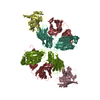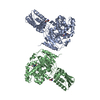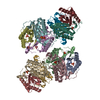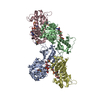+ Open data
Open data
- Basic information
Basic information
| Entry | Database: EMDB / ID: EMD-1761 | |||||||||
|---|---|---|---|---|---|---|---|---|---|---|
| Title | Single particle analysis of PSD-95 in negative stain | |||||||||
 Map data Map data | 3d map of PSD-95 | |||||||||
 Sample Sample |
| |||||||||
 Keywords Keywords | Scaffold protein / Membrane associated Guanylate Kinase / PDZ / SH3 | |||||||||
| Function / homology |  Function and homology information Function and homology informationRHO GTPases activate CIT / positive regulation of AMPA glutamate receptor clustering / neuronal ion channel clustering / P2Y1 nucleotide receptor binding / Neurexins and neuroligins / beta-1 adrenergic receptor binding / neuroligin family protein binding / structural constituent of postsynaptic density / synaptic vesicle maturation / positive regulation of neuron projection arborization ...RHO GTPases activate CIT / positive regulation of AMPA glutamate receptor clustering / neuronal ion channel clustering / P2Y1 nucleotide receptor binding / Neurexins and neuroligins / beta-1 adrenergic receptor binding / neuroligin family protein binding / structural constituent of postsynaptic density / synaptic vesicle maturation / positive regulation of neuron projection arborization / regulation of grooming behavior / receptor localization to synapse / protein localization to synapse / vocalization behavior / cerebellar mossy fiber / proximal dendrite / LGI-ADAM interactions / cellular response to potassium ion / Trafficking of AMPA receptors / dendritic branch / neuron spine / negative regulation of receptor internalization / Activation of Ca-permeable Kainate Receptor / AMPA glutamate receptor clustering / dendritic spine morphogenesis / establishment or maintenance of epithelial cell apical/basal polarity / frizzled binding / juxtaparanode region of axon / dendritic spine organization / neuron projection terminus / postsynaptic neurotransmitter receptor diffusion trapping / acetylcholine receptor binding / Synaptic adhesion-like molecules / positive regulation of synapse assembly / regulation of NMDA receptor activity / RAF/MAP kinase cascade / positive regulation of dendrite morphogenesis / beta-2 adrenergic receptor binding / neurotransmitter receptor localization to postsynaptic specialization membrane / cortical cytoskeleton / extrinsic component of cytoplasmic side of plasma membrane / locomotory exploration behavior / regulation of neuronal synaptic plasticity / kinesin binding / AMPA glutamate receptor complex / social behavior / excitatory synapse / neuromuscular process controlling balance / positive regulation of protein tyrosine kinase activity / positive regulation of excitatory postsynaptic potential / D1 dopamine receptor binding / Unblocking of NMDA receptors, glutamate binding and activation / glutamate receptor binding / positive regulation of synaptic transmission / ionotropic glutamate receptor binding / dendrite cytoplasm / cell periphery / synaptic membrane / PDZ domain binding / postsynaptic density membrane / regulation of long-term neuronal synaptic plasticity / establishment of protein localization / neuromuscular junction / kinase binding / cerebral cortex development / cell-cell adhesion / cell-cell junction / cell junction / synaptic vesicle / positive regulation of cytosolic calcium ion concentration / scaffold protein binding / protein-containing complex assembly / basolateral plasma membrane / chemical synaptic transmission / protein phosphatase binding / postsynaptic membrane / postsynapse / dendritic spine / postsynaptic density / neuron projection / signaling receptor binding / glutamatergic synapse / dendrite / synapse / protein-containing complex binding / protein kinase binding / endoplasmic reticulum / membrane / plasma membrane / cytosol / cytoplasm Similarity search - Function | |||||||||
| Biological species |  | |||||||||
| Method | single particle reconstruction / negative staining / Resolution: 22.9 Å | |||||||||
 Authors Authors | Fomina S / Howard TD / Sleator OK / Golovanova M / O'Ryan L / Leyland M / Grossmann JG / Collins RF / Prince SM | |||||||||
 Citation Citation |  Journal: Biochim Biophys Acta / Year: 2011 Journal: Biochim Biophys Acta / Year: 2011Title: Self-directed assembly and clustering of the cytoplasmic domains of inwardly rectifying Kir2.1 potassium channels on association with PSD-95. Authors: Svetlana Fomina / Tina D Howard / Olivia K Sleator / Marina Golovanova / Liam O'Ryan / Mark L Leyland / J Günter Grossmann / Richard F Collins / Stephen M Prince /  Abstract: The interaction of the extra-membranous domain of tetrameric inwardly rectifying Kir2.1 ion channels (Kir2.1NC(4)) with the membrane associated guanylate kinase protein PSD-95 has been studied using ...The interaction of the extra-membranous domain of tetrameric inwardly rectifying Kir2.1 ion channels (Kir2.1NC(4)) with the membrane associated guanylate kinase protein PSD-95 has been studied using Transmission Electron Microscopy in negative stain. Three types of complexes were observed in electron micrographs corresponding to a 1:1 complex, a large self-enclosed tetrad complex and extended chains of linked channel domains. Using models derived from small angle X-ray scattering experiments in which high resolution structures from X-ray crystallographic and Nuclear Magnetic Resonance studies are positioned, the envelopes from single particle analysis can be resolved as a Kir2.1NC(4):PSD-95 complex and a tetrad of this unit (Kir2.1NC(4):PSD-95)(4). The tetrad complex shows the close association of the Kir2.1 cytoplasmic domains and the influence of PSD-95 mediated self-assembly on the clustering of these channels. | |||||||||
| History |
|
- Structure visualization
Structure visualization
| Movie |
 Movie viewer Movie viewer |
|---|---|
| Structure viewer | EM map:  SurfView SurfView Molmil Molmil Jmol/JSmol Jmol/JSmol |
| Supplemental images |
- Downloads & links
Downloads & links
-EMDB archive
| Map data |  emd_1761.map.gz emd_1761.map.gz | 216.6 KB |  EMDB map data format EMDB map data format | |
|---|---|---|---|---|
| Header (meta data) |  emd-1761-v30.xml emd-1761-v30.xml emd-1761.xml emd-1761.xml | 11.8 KB 11.8 KB | Display Display |  EMDB header EMDB header |
| Images |  emd_1761.png emd_1761.png | 91 KB | ||
| Archive directory |  http://ftp.pdbj.org/pub/emdb/structures/EMD-1761 http://ftp.pdbj.org/pub/emdb/structures/EMD-1761 ftp://ftp.pdbj.org/pub/emdb/structures/EMD-1761 ftp://ftp.pdbj.org/pub/emdb/structures/EMD-1761 | HTTPS FTP |
-Validation report
| Summary document |  emd_1761_validation.pdf.gz emd_1761_validation.pdf.gz | 214.6 KB | Display |  EMDB validaton report EMDB validaton report |
|---|---|---|---|---|
| Full document |  emd_1761_full_validation.pdf.gz emd_1761_full_validation.pdf.gz | 213.7 KB | Display | |
| Data in XML |  emd_1761_validation.xml.gz emd_1761_validation.xml.gz | 4.7 KB | Display | |
| Arichive directory |  https://ftp.pdbj.org/pub/emdb/validation_reports/EMD-1761 https://ftp.pdbj.org/pub/emdb/validation_reports/EMD-1761 ftp://ftp.pdbj.org/pub/emdb/validation_reports/EMD-1761 ftp://ftp.pdbj.org/pub/emdb/validation_reports/EMD-1761 | HTTPS FTP |
-Related structure data
| Related structure data |  2xkxMC  1764C  1765C  1766C  2xkyC M: atomic model generated by this map C: citing same article ( |
|---|---|
| Similar structure data |
- Links
Links
| EMDB pages |  EMDB (EBI/PDBe) / EMDB (EBI/PDBe) /  EMDataResource EMDataResource |
|---|---|
| Related items in Molecule of the Month |
- Map
Map
| File |  Download / File: emd_1761.map.gz / Format: CCP4 / Size: 422.9 KB / Type: IMAGE STORED AS FLOATING POINT NUMBER (4 BYTES) Download / File: emd_1761.map.gz / Format: CCP4 / Size: 422.9 KB / Type: IMAGE STORED AS FLOATING POINT NUMBER (4 BYTES) | ||||||||||||||||||||||||||||||||||||||||||||||||||||||||||||||||||||
|---|---|---|---|---|---|---|---|---|---|---|---|---|---|---|---|---|---|---|---|---|---|---|---|---|---|---|---|---|---|---|---|---|---|---|---|---|---|---|---|---|---|---|---|---|---|---|---|---|---|---|---|---|---|---|---|---|---|---|---|---|---|---|---|---|---|---|---|---|---|
| Annotation | 3d map of PSD-95 | ||||||||||||||||||||||||||||||||||||||||||||||||||||||||||||||||||||
| Projections & slices | Image control
Images are generated by Spider. | ||||||||||||||||||||||||||||||||||||||||||||||||||||||||||||||||||||
| Voxel size | X=Y=Z: 3.667 Å | ||||||||||||||||||||||||||||||||||||||||||||||||||||||||||||||||||||
| Density |
| ||||||||||||||||||||||||||||||||||||||||||||||||||||||||||||||||||||
| Symmetry | Space group: 1 | ||||||||||||||||||||||||||||||||||||||||||||||||||||||||||||||||||||
| Details | EMDB XML:
CCP4 map header:
| ||||||||||||||||||||||||||||||||||||||||||||||||||||||||||||||||||||
-Supplemental data
- Sample components
Sample components
-Entire : Rat PSD-95
| Entire | Name: Rat PSD-95 |
|---|---|
| Components |
|
-Supramolecule #1000: Rat PSD-95
| Supramolecule | Name: Rat PSD-95 / type: sample / ID: 1000 / Oligomeric state: Monomer / Number unique components: 1 |
|---|---|
| Molecular weight | Experimental: 95 KDa / Theoretical: 78 KDa / Method: SDS-PAGE |
-Macromolecule #1: PSD-95
| Macromolecule | Name: PSD-95 / type: protein_or_peptide / ID: 1 / Name.synonym: PSD-95 / Number of copies: 1 / Oligomeric state: Monomer / Recombinant expression: Yes |
|---|---|
| Source (natural) | Organism:  |
| Molecular weight | Experimental: 95 KDa / Theoretical: 78 KDa |
| Recombinant expression | Organism:  |
| Sequence | GO: neuronal ion channel clustering / InterPro: Disks large 1-like |
-Experimental details
-Structure determination
| Method | negative staining |
|---|---|
 Processing Processing | single particle reconstruction |
| Aggregation state | particle |
- Sample preparation
Sample preparation
| Concentration | 1 mg/mL |
|---|---|
| Buffer | pH: 7.5 / Details: 20mM Tris/HCl, 5mM DTT, 1mM EDTA, |
| Staining | Type: NEGATIVE Details: Samples were adsorbed onto freshly glow discharged carbon film grids. Sample solution was pipetted into the grid followed by blotting, de-ionized water was then applied for 10s followed by ...Details: Samples were adsorbed onto freshly glow discharged carbon film grids. Sample solution was pipetted into the grid followed by blotting, de-ionized water was then applied for 10s followed by blotting, 2%w/v Uranyl Acetate solution was applied followed by a final blotting step. |
| Grid | Details: 400 mesh Copper |
| Vitrification | Cryogen name: NONE / Instrument: OTHER |
- Electron microscopy
Electron microscopy
| Microscope | FEI TECNAI 10 |
|---|---|
| Details | Low dose |
| Image recording | Category: FILM / Film or detector model: GENERIC FILM / Digitization - Scanner: OTHER / Digitization - Sampling interval: 15 µm / Number real images: 2 / Details: none / Od range: 2 / Bits/pixel: 8 |
| Tilt angle min | 0 |
| Tilt angle max | 0 |
| Electron beam | Acceleration voltage: 100 kV / Electron source: TUNGSTEN HAIRPIN |
| Electron optics | Illumination mode: FLOOD BEAM / Imaging mode: BRIGHT FIELD / Cs: 3.6 mm / Nominal defocus max: 2.25 µm / Nominal defocus min: 0.9 µm / Nominal magnification: 43000 |
| Sample stage | Specimen holder: Eucentric / Specimen holder model: PHILIPS ROTATION HOLDER |
- Image processing
Image processing
| Details | Particles selected using model based picking using an ab-initio model from Small angle X-ray scattering |
|---|---|
| CTF correction | Details: Paramters determined using Scattering curve |
| Final reconstruction | Applied symmetry - Point group: C1 (asymmetric) / Resolution.type: BY AUTHOR / Resolution: 22.9 Å / Resolution method: FSC 0.5 CUT-OFF / Software - Name: EMAN / Number images used: 7854 |
| Final two d classification | Number classes: 84 |
-Atomic model buiding 1
| Initial model | PDB ID: |
|---|---|
| Software | Name:  Chimera Chimera |
| Details | Model assembled using SAXS refinement and docked |
| Refinement | Space: REAL |
| Output model |  PDB-2xkx: |
-Atomic model buiding 2
| Initial model | PDB ID: |
|---|---|
| Software | Name:  Chimera Chimera |
| Details | Model assembled using SAXS refinement and docked |
| Refinement | Space: REAL |
| Output model |  PDB-2xkx: |
-Atomic model buiding 3
| Initial model | PDB ID: |
|---|---|
| Software | Name:  Chimera Chimera |
| Details | Model assembled using SAXS refinement and docked |
| Refinement | Space: REAL |
| Output model |  PDB-2xkx: |
 Movie
Movie Controller
Controller













 Z (Sec.)
Z (Sec.) Y (Row.)
Y (Row.) X (Col.)
X (Col.)

























